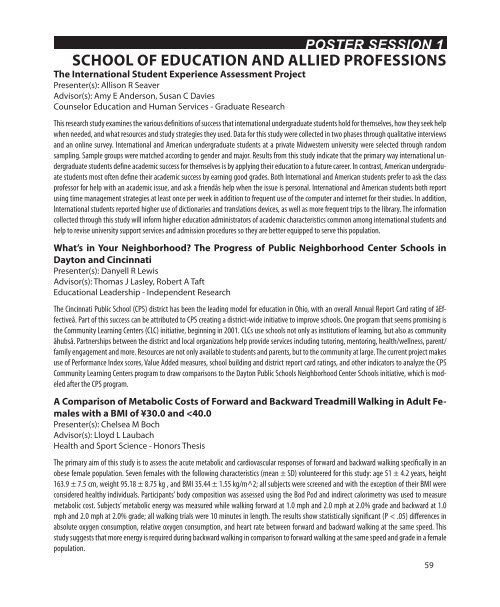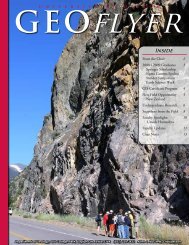Stander Symposium abstract book - University of Dayton
Stander Symposium abstract book - University of Dayton
Stander Symposium abstract book - University of Dayton
Create successful ePaper yourself
Turn your PDF publications into a flip-book with our unique Google optimized e-Paper software.
POSTER SESSION 1<br />
SCHOOL OF EDUCATION AND ALLIED PROFESSIONS<br />
The International Student Experience Assessment Project<br />
Presenter(s): Allison R Seaver<br />
Advisor(s): Amy E Anderson, Susan C Davies<br />
Counselor Education and Human Services - Graduate Research<br />
This research study examines the various definitions <strong>of</strong> success that international undergraduate students hold for themselves, how they seek help<br />
when needed, and what resources and study strategies they used. Data for this study were collected in two phases through qualitative interviews<br />
and an online survey. International and American undergraduate students at a private Midwestern university were selected through random<br />
sampling. Sample groups were matched according to gender and major. Results from this study indicate that the primary way international undergraduate<br />
students define academic success for themselves is by applying their education to a future career. In contrast, American undergraduate<br />
students most <strong>of</strong>ten define their academic success by earning good grades. Both International and American students prefer to ask the class<br />
pr<strong>of</strong>essor for help with an academic issue, and ask a friendâs help when the issue is personal. International and American students both report<br />
using time management strategies at least once per week in addition to frequent use <strong>of</strong> the computer and internet for their studies. In addition,<br />
International students reported higher use <strong>of</strong> dictionaries and translations devices, as well as more frequent trips to the library. The information<br />
collected through this study will inform higher education administrators <strong>of</strong> academic characteristics common among international students and<br />
help to revise university support services and admission procedures so they are better equipped to serve this population.<br />
What’s in Your Neighborhood? The Progress <strong>of</strong> Public Neighborhood Center Schools in<br />
<strong>Dayton</strong> and Cincinnati<br />
Presenter(s): Danyell R Lewis<br />
Advisor(s): Thomas J Lasley, Robert A Taft<br />
Educational Leadership - Independent Research<br />
The Cincinnati Public School (CPS) district has been the leading model for education in Ohio, with an overall Annual Report Card rating <strong>of</strong> âEffectiveâ.<br />
Part <strong>of</strong> this success can be attributed to CPS creating a district-wide initiative to improve schools. One program that seems promising is<br />
the Community Learning Centers (CLC) initiative, beginning in 2001. CLCs use schools not only as institutions <strong>of</strong> learning, but also as community<br />
âhubsâ. Partnerships between the district and local organizations help provide services including tutoring, mentoring, health/wellness, parent/<br />
family engagement and more. Resources are not only available to students and parents, but to the community at large. The current project makes<br />
use <strong>of</strong> Performance Index scores, Value Added measures, school building and district report card ratings, and other indicators to analyze the CPS<br />
Community Learning Centers program to draw comparisons to the <strong>Dayton</strong> Public Schools Neighborhood Center Schools initiative, which is modeled<br />
after the CPS program.<br />
A Comparison <strong>of</strong> Metabolic Costs <strong>of</strong> Forward and Backward Treadmill Walking in Adult Females<br />
with a BMI <strong>of</strong> ¥30.0 and

















